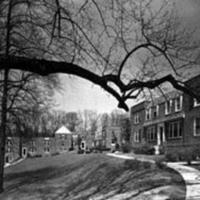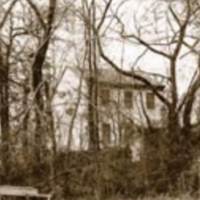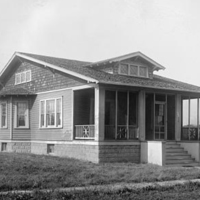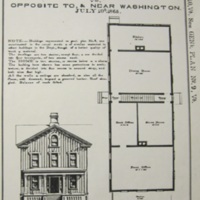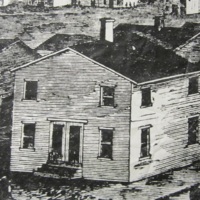Browse Items (6 items total)
Colonial Village is a garden-style apartment complex created by professional developer Gustave Ring in 1935. It contains more than 200 Colonial Revival red brick buildings surrounded by landscaped paths and lawns.
The development was created to help house the huge number of recently arrived federal employees using funds from the Federal Housing Administration (FHA). The Colonial Village complex was one of the first developments to work with the FHA and Ring helped shape their policies.
The development was created to help house the huge number of recently arrived federal employees using funds from the Federal Housing Administration (FHA). The Colonial Village complex was one of the first developments to work with the FHA and Ring helped shape their policies.
Collection: Neighborhoods
Levi Jones and his wife Sarah were two of the earliest settlers of Green Valley, today known as Nauck.
In 1844 the couple built a 14' x 16', two story log cabin. During the Civil War, federal troops destroyed their original home. But following the war they were able to rebuild, creating the home pictured here.
The Jones were influential community leaders. Before other accommodations could be made, they hosted church services in their home. They sold land to freed slaves following the Civil War. These sales, along with interest from Washington, D.C. land speculator John Nauck, a white businessman who sold land to African Americans in the Green Valley area, strengthened and expanded the black community there. Their impact on Nauck's black community continued into the twentieth century, when the federal government built the Paul Dunbar Homes on 11 of their original homestead in 1942.
Levi and Sarah had two sons, Levi and Isaac, and three daughters, Mary, Martha, and Louise. Levi died in 1886 and Sarah followed in 1913 at the age of 95. They are buried at the Lomax AME Cemetery.
In 1844 the couple built a 14' x 16', two story log cabin. During the Civil War, federal troops destroyed their original home. But following the war they were able to rebuild, creating the home pictured here.
The Jones were influential community leaders. Before other accommodations could be made, they hosted church services in their home. They sold land to freed slaves following the Civil War. These sales, along with interest from Washington, D.C. land speculator John Nauck, a white businessman who sold land to African Americans in the Green Valley area, strengthened and expanded the black community there. Their impact on Nauck's black community continued into the twentieth century, when the federal government built the Paul Dunbar Homes on 11 of their original homestead in 1942.
Levi and Sarah had two sons, Levi and Isaac, and three daughters, Mary, Martha, and Louise. Levi died in 1886 and Sarah followed in 1913 at the age of 95. They are buried at the Lomax AME Cemetery.
Collection: Neighborhoods
Bungalow homes, like this house in the Cherrydale neighborhood, were very popular in Arlington during the early twentieth century. The main characteristics of these homes are that they were one story with large front porches and sloping roofs. Bungalows came into fashion during the Progressive Era, as more ornate Victorian homes and ideals were rejected in favor of the simpler Bungalow style which pushed connection to nature, simplicity, and honesty. By WWI this was the most common housing type nationally and in Arlington.
Many of Arlington's Bungalow houses were purchased through the Sears Roebuck mail-order catalog. The practice of ordering homes through mail-order was more popular in Arlington's white neighborhoods than its African American neighborhoods. Sears houses could be found in not only Cherrydale, but also Clarendon, Lyon Village, Maywood, Lyon Park, Ashton Heights, Alcova, Aurora Hills, and Virginia Highlands. This home appears to be in "The Vallonia" style.
Many of Arlington's Bungalow houses were purchased through the Sears Roebuck mail-order catalog. The practice of ordering homes through mail-order was more popular in Arlington's white neighborhoods than its African American neighborhoods. Sears houses could be found in not only Cherrydale, but also Clarendon, Lyon Village, Maywood, Lyon Park, Ashton Heights, Alcova, Aurora Hills, and Virginia Highlands. This home appears to be in "The Vallonia" style.
Collection: Neighborhoods
In May of 1942, U.S. Farm Security Administration photographer John Collier took pictures of homes and subdivisions under construction in Arlington, Virginia. Arlington saw a great deal of construction during World War Two as new homes and new neighborhoods were created in Arlington Heights, Green Valley, Fairlington, and more for war workers flocking to Washington.
Collection: Neighborhoods
This plan for the Freedman's Village headquarters was created by the War Department in 1865. The government's continued investment in the Village and its infrastructure shows how even though the Village was created as a war aim, Freedman's Village continued to expand as an African American community in peace. The Four Square architectural style of the house was popular in Arlington and across the county in suburban landscapes of the late nineteenth century. The style is associated with early streetcar suburbs, like the ones which were just beginning to emerge in Arlington at the close of the Civil War.
Collection: Community Institutions
Freedman's Village was a contraband camp created by the War Department and strengthened by Arlington's African American community. The Village, located on the lands of Robert E. Lee's Arlington plantation, was a black neighborhood in Arlington from 1863 until 1900.
Here 100 white-washed, one-and-a-half story duplexes, like the one pictured, were constructed along a quarter-mile long thoroughfare through the Village. The clapboard houses used a paired-down version of the Classical Revival style. This housing type remained a popular choice for African American communities in Arlington throughout the early twentieth century.
Here 100 white-washed, one-and-a-half story duplexes, like the one pictured, were constructed along a quarter-mile long thoroughfare through the Village. The clapboard houses used a paired-down version of the Classical Revival style. This housing type remained a popular choice for African American communities in Arlington throughout the early twentieth century.
Collection: Neighborhoods
